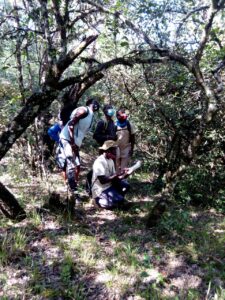The Covid 19 situation remains largely unchanged. We continue being vigilant – wearing masks, washing hands and working from home when we can.
Membership activities are taking place with caution:
- Wednesday Morning and Third Sunday bird walks continue this month. See back page for details.
- The October Big Day eBird birding challenge takes place on 9th October. Also see back page for details.
- A virtual talk: Spider: Friend or Enemy? by Grace Kioko will take place on 22nd October.
- The Nature Kenya office is closed. However, membership can be renewed online http://naturekenya.org/support/membership/ or via M-pesa. Books, honey, etc. may be purchased online or with M-Pesa and collected on Mondays or by arrangement. Ring the bell at the entrance of the office behind the galleries.
- Members will continue to receive an electronic version of the Nature Net.
- The EANHS/NMK Library is open to the public. Museum galleries and sites are open to the public under Ministry of Health guidelines.
Nature Kenya’s conservation work went on in September. Actions to save species, conserve habitats, encourage ecological sustainability and empower people were undertaken across various sites:
Species and Site Monitoring
Site Support Groups in Dakatcha Woodland, Arabuko-Sokoke Forest, Mt. Kenya Forest, Sabaki River estuary, Yala Swamp, Taita Hills, Tana River Delta, South Nandi forest and Mida Creek Key Biodiversity Areas (KBAs) conducted Common Bird Monitoring.
In Amboseli KBA, Nature Kenya trained 16 community volunteers on improved livestock herding practices. The training was aimed at reducing and mitigating human-wildlife conflicts.
In Arabuko-Sokoke, 21 newly-graduated community forest scouts were recruited to enhance forest surveillance in Jilore and Sokoke areas.
Habitat Restoration
The development of a geographic information system (GIS) to track habitat restoration progress in the Tana River Delta commenced. Once operational, community members will be trained on how to collect restoration GIS data and conduct mapping using smartphones. Data collected will be fed into a GIS-based geodatabase to generate real-time information for analysis.
Advocacy and Awareness Creation
In Kisumu, Friends of Dunga Swamp and the Ruma national park SSG submitted comments for an Environmental Impact Assessment (EIA) report for proposed sand harvesting at Sondu Miriu River Delta.
The Chebororwa Sekemiat Self-help Group and Cherangany Hills Community-based Organization submitted memoranda on Elgeyo Marakwet County Annual Development Plan 2022/2023 while Tana Delta Conservation Network submitted comments for the Tana River County Finance Bill 2021.
Livelihoods Improvement
Nature Kenya is piloting innovative approaches to build community resilience in drought-stricken areas around Key Biodiversity Areas. This includes promoting resilient community livelihoods like rearing of improved indigenous chicken and goat breeds, climate-smart agriculture and beekeeping, among others.
In Tana Delta, 285 chilli farmers have entered into contract farming with Equator Kenya Ltd. Two of them started harvesting the high-value crop, earning Ksh. 53,946 from 899 kilograms in September.
Despite the prevailing drought, farmers in the Delta have so far realized Ksh. 951,232 from the sale of maize, green grams and cowpeas under the same initiative.
With your support, we can empower more communities across Kenya to be resilient.
For clarifications or to report your observations on species and sites, kindly contact us through email: office@naturekenya.org or telephone: 020 3537568, 0780 149200, 0751 624312, 0771 343138
Dr Paul Matiku,
Executive Director, Nature Kenya – the East Africa Natural History Society

